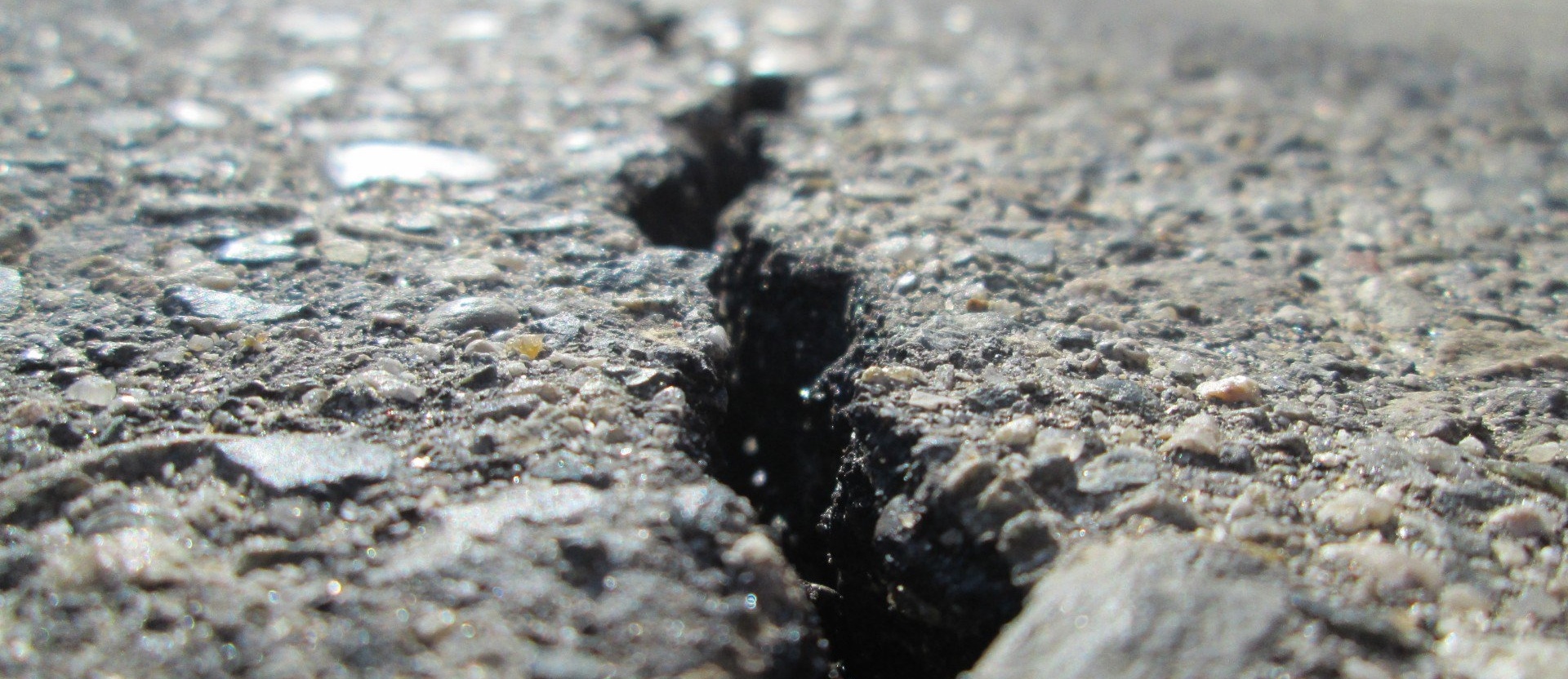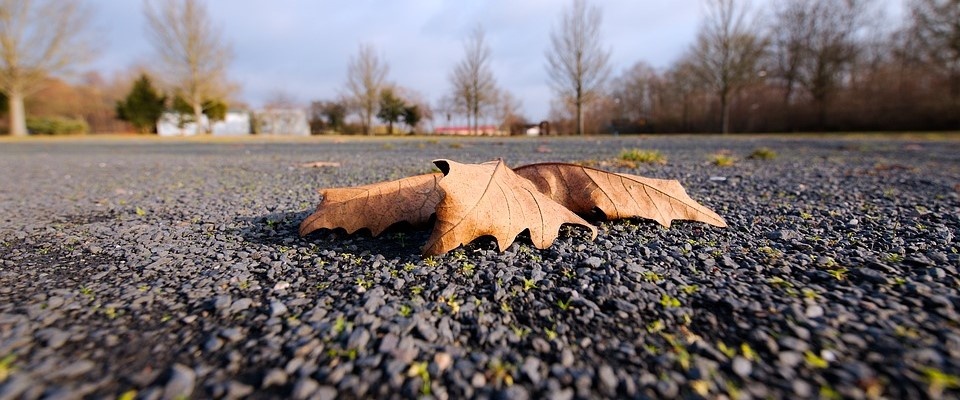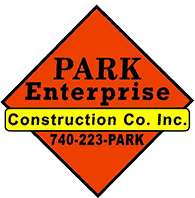
Putting off routine maintenance WILL cost more in the long run. Instead of small maintenance tasks, you’ll need to completely replace your asphalt parking lot. This is expensive for a few reasons:
- Paving an entire parking lot is expensive. Period.
- Having sections of your parking lot (or the whole lot) unavailable can deter customers.
- You may have to temporarily shut down your business for the paving process.
- You’ll probably have to pay for patches and emergency maintenance before you can actually get it repaved.
- It’s rare (but possible) that you can run into liability issues if someone injuries themselves or damages their car due to your poorly maintained parking lot.
Click here for a printable parking lot maintenance checklist!
Repaving your asphalt parking lot can cost up to 25% more than performing routine maintenance. If you’ve got a 20,000 sq. ft. lot, that adds up quickly.
Even the bare minimum (applying a thin asphalt overlay every 10 years) is ultimately less expensive than a complete overhaul every 15-20 years.
Parking lot maintenance, repair, or repaving?
First thing’s first: is your parking lot actually in a state that you can maintain successfully, or do you need to start from scratch with repaving?
Assess your commercial parking lot with these four questions:
- Is it safe for cars and people? Could someone get hurt or damage their car in a crack, sinkhole, or pothole?
- Is it functional? Are the signs and lines clearly visible?
- Is it visually appealing? Does it create a welcoming first impression for my customers?
- If there’s damage, is it minor enough for patching, sealcoating, or an asphalt overlay to get back in working order? Or is it so severe that parts or your entire lot will need to be milled down and replaced?
If you feel good about those questions, let’s get started on parking lot maintenance.

Asphalt Parking Lot Maintenance for Property Owners
Successful asphalt parking lot maintenance covers five major issues:
- Cracks
- Drainage
- Surface quality
- Potholes
- Debris (oil & organic materials)
1. Sealing Cracks
Asphalt expands and contracts with heat, cold, and water infiltration. That means cracks will be among your lot’s first signs of aging. The sooner you seal these cracks, the longer your entire parking lot will last.
Some cracks can simply be cleaned, sealed, and left for the next temporary repair. Your choice of sealant will depend on pavement conditions, weather, and traffic flow.
Flexible sealants are best used in cooler climates, for instance, because they’re flexible enough to accommodate the expansion, contraction, and heaving caused by the freeze-thaw cycle.
For Severe Cracking
In some instances, cracks must be pretreated. This may require sawing or routing to deepen, widen, and square the crack. Some experts believe this extends the sealant’s life by about 50%.
Watch out for mud pumping - sometimes a crack, pothole, or sinkhole will pump mud up from beneath your lot. That’s a telltale sign the subsurface is deteriorating. It’s only a matter of time until that particular spot (or the entire lot) needs to be replaced.
NOTE: If you have ruts that run down into the subgrade, your only real choice is to tear the old lot up and repave it.
2. Allowing Proper Drainage for Your Parking Lot
Your asphalt lot is actually porous. Water runoff and standing water erode the top layer and weaken sublayers. This erosion causes issues like cracks mentioned above.
In winter, the damage can be severe as water continually infiltrates your asphalt, freezes, thaws, and repeats. This has a compounding effect, allowing more water to trickle beneath and erode lower layers.
Aside from cracks mentioned above, a parking lot without proper drainage creates sinkholes, standing water, and potholes.
Sinkholes
Parking lot sinkholes occur most commonly in the spring around stormwater catch basins.
The spring thaw often inundates storm sewer systems with thousands or even millions of gallons of runoff. The stress can cause these underground utilities to crack and break, allowing water to leak out and erode the subsurface surrounding catch basins. Catch basins are basically sinkholes waiting to happen, and it’s not uncommon for the asphalt to collapse in on itself.
Look out for unexplained cracking and heaving near catch basins. They’re the first calling card of sinkholes. Sinkholes have been known to swallow entire vehicles, nearby structures, and sometimes even people.
Standing Water
Standing water is much less dramatic than a sinkhole, but just as damaging. It slowly erodes your asphalt, creating costly surface issues.
Vehicles and weather continuously erode certain sections of your parking lot. Water naturally pools in those areas. If you notice standing water, it's time to address drainage issues or consider a patch to level these surfaces.
How to Ensure Proper Parking Lot Drainage
You have a few options to help your parking lot drain properly.
Storm Drains
Plan and install a storm sewer or gravitational drainage system where water naturally pools. You’ll likely have to rope off a section of your lot while this is being installed.
Parking Lot Slope
Slope your lot with the proper angle and direction to keep water from pooling. Depending on your parking lot design, this may only require a small asphalt addition.
Curbing
You can redirect the flow of water with asphalt curbing. The water will follow the line of the curb to an appropriate drainage point.
Monitor Other Water Sources
Do you use sprinklers near your parking lot? Do your gutters point at the asphalt? Take inventory of all possible sources of water and redirect them as necessary.
3. Fixing Potholes
Potholes begin with poor drainage. Especially in cooler, wetter climates (like right here in central Ohio), water easily infiltrates, erodes, freezes, and expands through winter and spring.
If you only have one or two small potholes, you can probably patch them up yourself with the sealcoating treatments listed under #4 below. However, you may require a full parking lot overhaul after the snow melts.
For small pothole repair, make sure you do the following:
- Get any junk out of the bottom of the pothole
- Establish a new foundation in the pothole if necessary
- Lay equal, level layers of new asphalt until the hole is filled
4. Sealcoating & Large Area Surface Treatments
Untreated surfaces are subject to premature damage from the elements and petroleum products. The industry recommendation is to perform a sealcoating of your driving surface once every 3-5 years, although some commercial property owners choose to do so more frequently.
Sealant will be a barrier from damaging water and a temporary bonding agent for small pores and cracks that are destined to expand. A thin layer of surface treatment should be enough to stave off the elements for a significant period of time.
The strong, smooth, black layer also looks sharp - especially with freshly painted parking stripes.
Asphalt Surface Treatment Options
All of these will help prevent water infiltration and slow the effects of weather on your parking lot:
Fog Seals
A fog seal is a thin layer of slowly curing asphalt emulsion, which is a combination of liquid asphalt cement, water, and an emulsifying agent. This mainly slows asphalt deterioration.
Chip Seals
Chip seals are a thin treatment of one or several asphalt layers, plus a layer or more of fine-grade construction aggregate. It fills and seals damaged asphalt while helping to prevent reflective cracking, which is a type of crack that forms directly above a previously existing crack underneath it.
Microsurfacing
Microsurfacing is a thin layer of asphalt emulsion and fine-grade construction aggregate. It fixes minor rutting in asphalt and is preferred for its rapid curing time.
Cold Patch
A cold patch is only a temporary fix prior to a larger parking lot repair or replacement project. It’s a cold mix of aggregate, recycled asphalt, and tar-like asphalt binder. A cold patch is a quick fix you can perform yourself.
Hot Patch
This method uses the real deal: Hot mix asphalt. The hot asphalt is poured into the hole, leveled, and compacted. This kind of asphalt sealant is stronger and will last longer.
You or your contractor also must seal the joints (where new asphalt meets old) with rubberized crack filler for a sturdier connection.
Remember: even with these sealants and patches, you should still apply a new thin asphalt overlay every 10 years.
5. Clearing Debris Regularly
Everyday debris might be the most unexpected threat to your asphalt parking lot. Weeds, engine oil, trash, and other items can weaken your lot - not severely, but enough that the real danger (water) can find its way below the surface. It can also clog sewers and storm drains, creating standing pools or redirecting runoff onto your lot.
To prevent these issues, perform the following maintenance tasks regularly:
- Sweeping
- Clearing engine oil
- Weeding cracks
- Picking up sticks, leaves, and rocks
- Cleaning up litter and garbage
- Digging junk out of any potholes
Asphalt Parking Lot Maintenance Checklist
To stay on top of your parking lot’s health, make sure you’re regularly:
- Filling cracks
- Addressing water or drainage issues
- Checking for potholes
- Treating the surface of your lot
- Removing litter and debris
These quick, frequent tasks will save you a whole lot of money and headache in the long run.
Click here for a printable parking lot maintenance checklist!




